

International
Labour Organization
Your health and safety at work
CONTROLLING HAZARDS
If a particularly dangerous chemical or work process cannot be completely eliminated, then try to replace it with a safer substitute.

This could involve, for example, using less hazardous pesticides such as those based on pyrethrins (prepared from natural products), which are thought to be less toxic to humans than some other pesticides. This particular substitution is practised in some countries because the substitute chemicals do not leave residues on food and therefore reduce long-term costs. However, the substitute materials may cost more to buy and may cause resistance in insects. So you can see there are many factors to consider when choosing a chemical or chemical substitute. For more information on hazardous chemicals, see Appendices I and II at the back of this Module.
It is not easy to find “safer” chemical substitutes (in fact, no chemical should be considered completely safe). It is important to review every year or so current reports on the chemicals used in your workplace because chemicals considered to be “safer” substitutes today may not be considered safer in the future.
When you look for safer substitutes, try to choose a less volatile (volatile liquids vaporize, or evaporate easily) instead of a highly volatile one, choose a solid instead of a liquid, etc. For example, many dry, dusty powders are also available in brick, pellet, paste, flakes, oil damped powders, and other forms that create less dust when handled, and reduce the chance of inhaling the dust. Many plastics and rubber industry chemicals can also be supplied in dust-suppressed forms. These materials can be more expensive to purchase but they are safer for workers to handle and can be cheaper when other costs are considered, such as the cost of ventilation to control dust, personal protective equipment, etc.
Other examples of substitution include using:
Are substitute materials always safer than the original hazard?
No. When you choose substitute materials, try to find out if the new substance is really safer or not. There are examples where a material that was thought to be safer was found to be as bad as, or worse than, the original hazard. A classic example is asbestos. Fibreglass has been used as a substitute for asbestos; however, it is now known that fibreglass is also a hazardous material and is not a completely safe substitute for asbestos. A substitute may be better than the original hazard, but that does not mean it is safe. Water jets for drilling reduce dust but they do not reduce vibration, so workers still need protection.
Remember: protective measures are important when working with all chemicals, even if you are using a “safer” substitute.
Where can you get information on substitute materials?
First, check with your employer — he or she may have, or may be willing to get, information on hazards in your workplace. If you cannot get the information from your employer, try the chemical manufacturers — they should have hazard data sheets on all chemicals they manufacture. Other sources of information are: your union (local and national), the local factory or labour inspectorate, local colleges or universities, the local fire department, your local library, ITSs (International Trade Secretariats) and the ILO (International Labour Office). These groups may have information on hazard substitutes, or they may be able to help you get the information you need. For more information, read Appendix III (How to find a safer alternative to a dangerous chemical) at the back of this Module.
| What other resources can you think of? | 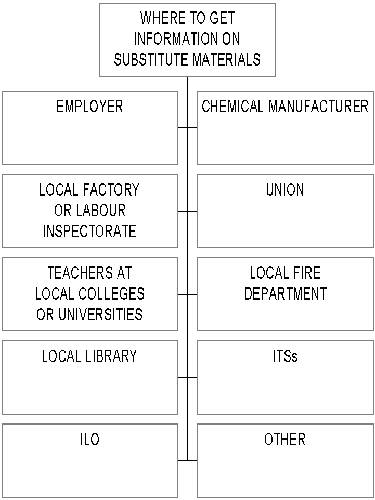 |
Can dangerous work processes be substituted with safer processes?
Yes. Changing the way you do a job so that it is safer is another form of substitution. For example, vacuuming up dust instead of sweeping it, or using “wet methods” to control dust are safer ways to work with dusty materials. “Wet methods” mean spraying water over a dusty surface to keep dust down, or mixing water with the material used to prevent dust from being created. Another is using a water jet for drilling and mining and quarrying instead of dry drilling. These methods reduce the amount of dust in the air.
Note: Use a vacuum cleaner when cleaning up toxic dust. Never sweep toxic dust with brooms or brushes — sweeping puts the dangerous dust back into the air where you can breathe it.
Use a vacuum cleaner when cleaning up toxic dust. Never sweep toxic dust - sweeping puts the dangerous dust back into the air where you can breathe it. |
 |
Other examples of changing a work process and/or the equipment used include using:
Example “A” Example “B” |
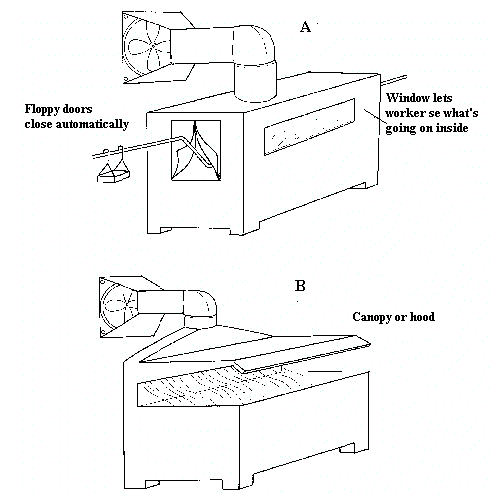 |
Example “C” |
 |
 |
|
|
|
There are a number of common control measures which are called “engineering controls”. These include enclosure, isolation and ventilation.
If a hazardous substance or work process cannot be eliminated or substituted, then enclosing it so workers are not exposed to the hazard is the next best method of control. Many hazards can be controlled by partially or totally enclosing the work process. Highly toxic materials that can be released into the air should be totally enclosed, usually by using a mechanical handling device or a closed glove system that can be operated from the outside.
Whole areas of a plant can be “enclosed” by requiring workers to operate those areas from a control room. Enclosing hazards can minimize possible exposures, but does not eliminate them. For example, maintenance workers who service or repair these “enclosed” areas can still be exposed. To prevent maintenance workers from being exposed, other protective measures (such as protective clothing, respirators, proper training, medical surveillance, etc.) must be used, as well as safety procedures.
Machine guarding is another form of enclosure that prevents workers from coming into contact with dangerous parts of machines. Workers should receive training on how to use guarded machines safely. Some of the areas of a machine that can injure you are: the point of operation (which is the area on a machine where work is actually being performed); pinch-points; sharp areas, such as blades; exposed electrical components, which can cause electrical shock or burns; presses, which can crush; rotating parts; flying chips and sparks.
Here are a few examples of types of machine guards:
Enclosure guards: prevent you from coming into contact with the dangerous moving parts of a machine by enclosing the parts or forming a barrier around the dangerous parts. This type of guard also prevents broken and flying machine parts from hitting you.
Interlocking guards: prevent you from operating the machine if the guard is not in place, or automatically stop the machine if part of your body enters a dangerous area. Photoelectrical or mechanical-sensing devices (such as a photoelectric eye) are examples of interlocking guards.
Automatic guards: actually pull or push your hands, arms, or body away from the danger zone as the work is being done.
Remote control, feeding, placement or ejecting guards: these control methods protect you from dangerous points of operation. For example, a two-handed control requires both of your hands to be on the controls (away from the danger zone) when you operate the machine. This is a common method with punch/stamping presses; a feeding mechanism may use an automatic device to feed material into the machine, so that you do not feed by hand.
Designing machine guards
Guards can often be built at your workplace at low cost. Here are some helpful points for designing and building machine guards.
Before working with any machine, ask yourself: “How can this machine be made safer to operate?” Use section I, in the Check-list on control methods (I. Machine guards) at the back of this Module to help you assess the machine guards in your workplace.
Unguarded machines are hazardous |
 |
Isolation can be an effective method of control if a hazardous job can be moved to a part of the workplace where fewer people will be exposed, or if a job can be changed to a shift when fewer people are exposed (such as a weekend or midnight shift). The worker can also be isolated from a hazardous job, for example by working in an air-conditioned control booth.
Safety devices on machinery |
 |
No single isolation method is effective on its own. Isolation methods should be used in combination to minimize the chance of exposure. |
 |
Whether it is the job or the worker that is isolated, access to the hazardous work area should be limited to as few people as possible to reduce exposures. It is also important to limit the length of time and the amount of a substance(s) to which workers are exposed if they must work in the hazardous area. For example, dust-producing work should be isolated from other work areas to prevent other workers from being exposed. At the same time, workers in the dusty areas must be protected and restricted to only a short time working in those areas.
Remember: isolating the work process or the worker does not eliminate the hazard, which means workers can still be exposed.
Ventilation in the workplace can be used for two reasons: (1) to prevent the work environment from being too hot, cold, dry or humid; (2) to prevent contaminants in the air from getting into the area where workers breathe. Generally there are two categories of ventilation: local exhaust ventilation and general ventilation. Whatever the type, ventilation should be used together with other methods of control.
Local exhaust ventilation usually uses suction, based on the principle of a vacuum cleaner, to remove pollutants from the air. There are two common types of local exhaust ventilation used in industry today: (1) fumes are sucked into an open tank with side slots and into a closed system, through which they are then transferred to a disposal point away from the workers (a degreasing tank is an example of this); (2) fumes are sucked into a canopy hood which hangs over a contaminant and forced out through a ventilation duct. This type is very effective where the air pollutants have a high temperature, or if they rise in the air for another reason (for example, the heat from furnaces or ovens causes pollutants to rise).
Exhaust ventilation can also include the use of flexible piping. The end of the pipe that draws in the contaminants (the inlet) must be placed as close as possible to the source of the hazard in order to be effective. Flexible piping is often used to draw welding fumes away from the worker and to draw away contaminants in work areas that are hard to reach. |
 |
Partial enclosure (such as laboratory fume cupboards or screens placed around welders) combined with a local exhaust ventilation system is one of the best solutions for controlling toxic material. This type of system must operate as close as possible to the source of the hazardous agent to reduce it from spreading, yet at the same time allow access to the work process. Use section II, Local exhaust ventilation in the Check-list on control methods at the back of this Module to help you assess the local exhaust ventilation system in your workplace.
General ventilation, which is generally used for keeping the workplace comfortable, is one of the least effective methods of controlling hazards but one of the most commonly used. The purpose of any general ventilation system is to remove contaminated air and replace it with “fresh” air. This system does not really remove hazardous agents from the air; it simply reduces the amounts in the air to levels that are considered “safe” for breathing. The effectiveness of a general ventilation system depends on several things, including: how quickly the hazardous agent is being released into the air; how much and how quickly fresh air is coming in; and how the contaminated air is being removed.
Unfortunately, many workplaces use general ventilation as the only source of ventilation. Air-bricks, windows and doors may be opened to increase the general flow of air. However, these openings are often blocked or shut. Doors and windows are sometimes locked for security reasons, air-bricks may be blocked by excess stock being stored across them, etc. Without good general ventilation, hazardous agents in the air can accumulate (sometimes to dangerous levels), and the workplace may become very hot, difficult to work in and dangerous.
Are fans a good source of ventilation?
No. Fans can only help to remove fumes, dusts, etc., but they should not be used as a primary source of general ventilation and should never be used as a method of removing toxic materials.
Does your workplace have some type of ventilation system in place that you assume is working properly? In many cases, the ventilation system is not effective because of poor design, lack of servicing, etc. Ventilation systems must be checked and serviced regularly. The best way to test how well the ventilation system in your workplace is working is with special equipment and personnel trained to use it. Unfortunately, the equipment and personnel can be hard to get. However, a simple way to see how well the ventilation extract system in your workplace is working is to sprinkle some dust or hold a piece of cloth near the exhaust outlet. If there is little air movement, then the ventilation system is not working properly and should be repaired.
 |
|
|
|
Administrative controls limiting the amount of time workers spend at a hazardous job can be used together with other methods of control to reduce exposure to hazards. Some examples of administrative controls include:
An example of administrative controls being used together with engineering controls and personal protective equipment is: a four-hour limit for work in a fully enclosed, high noise area where ear protectors are required.
Remember: administrative controls only reduce the amount of time you are exposed to a hazard - they do not eliminate exposures.
 |
|
|
|
E. Personal protective equipment
Personal protective equipment (PPE) is the least effective method of controlling occupational hazards and should be used only when other methods cannot control hazards sufficiently. PPE can be uncomfortable, can decrease work performance and can create new health and safety hazards. For example, ear protectors can prevent you from hearing warning signals, respirators can make it harder to breathe, earplugs may cause infection, and leaky gloves can trap hazardous chemicals against the skin.

Examples of PPE include:

PPE should be acceptable only when your employer cannot control hazards with engineering controls. However, if it is impossible to reduce hazards so that there is no health risk to workers, then PPE must be used.
PPE puts a barrier between the worker and the hazard. PPE may keep the hazard out, but it also keeps heat and water vapour in the protective clothing, which can cause you to be hot and uncomfortable. When wearing PPE, drink plenty of water and take frequent breaks. In hot or humid working conditions, you can only wear PPE for a short time (even as little as ten minutes in very hot conditions) before you need to take a break. Heat and humidity can also decrease the effectiveness of some protective equipment; for example, a respirator mask may not have a tight seal if your face is wet with perspiration or water.
How do you know what type of PPE to use?
The type of PPE you need to use depends on the hazard, how exposure can affect your body, and how long you will be exposed. For example, if the hazard is a dust, then you need to wear a respirator with a filter that is appropriate for that type of dust, or wear a respirator connected to a source of breathing air. Unfortunately, workers are often given the wrong PPE, such as a dust respirator when the hazard is a fume or vapour.
Three types of half mask with filter. Top: as protection against airborne particles, e.g. stone dust. Middle: as protection against gases and fumes, e.g. when using paints containing solvents. This filter contains activated carbon. Bottom: with a combination filter containing both a dust and a gas filter. These masks are examples of the simplest effective respiratory protection. Replace the filter when it gets harder to breathe or when it begins to smell. Replace the filter frequently. |
1. Prefilter 2. Dust filter Gas filter Combination filter |
 |
| Protection for: | Type of gear | ||
Make sure none of your protective gear is made of asbestos |
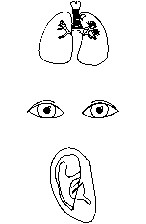 |
airway lungs
eyes
ears |
respirators, mask
goggles, glasses, polarizers
muffs, plugs |
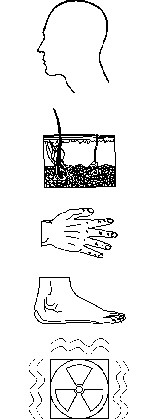 |
head
skin
hands
feet against |
helmets, hats
chemical resistant clothing, aprons
special gloves, rubber finger-coats
work shoes, boots metal-lined shields and aprons |
Protective clothing should fit you well in order to give you the best protection. PPE is usually designed for the “average” North American or European worker, which can be a problem if you are above or below their average height or weight. However, it is possible to purchase large and small sizes of protective clothing for both men and women. If you wear a respirator, a beard, a large moustache or eyeglasses make it impossible to get a good seal - if your mask does not have a good seal you can breathe in hazards. All PPE should be checked for holes or air leakage. Look for signs of leaks, such as dust near the nose, or dust in the nose hairs.
| WRONG! | RIGHT! | |
Depending on their chemical composition, pesticides can cause serious poisoning, including nerve damage and skin and eye damage. Early symptoms may include headache, nausea, dizziness and loss of strength. Use caution when handling chemical substances. USE THE APPROPRIATE SAFETY EQUIPMENT. |
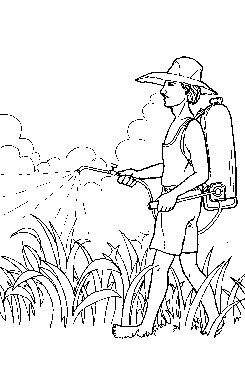 |
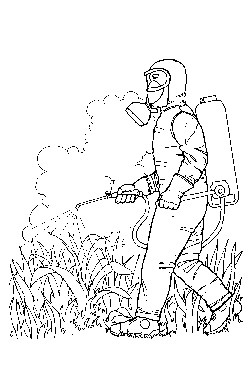 |
Sometimes workers use barrier creams to prevent hazards from getting through the skin on their hands and arms. Barrier creams are not very effective and can even cause more exposure to hazards by trapping dusts next to the skin or causing chemicals to get through skin. Barrier creams can help you remove dirt when you wash your skin, but they are not a substitute for hazard-specific gloves.
Do you need training to use PPE?
Yes! You should be trained in the proper use, care, maintenance and limitations of any type of PPE that you need to use to do your job safely. You should also receive additional training at least once a year. If you use PPE you should be in a medical surveillance programme at work. Use section III, Personal protective equipment in the Check-list on control methods at the back of this Module to help you assess the personal protective equipment used in your workplace.
You should be properly trained in the use, care, maintenance and limitations of PPE. |
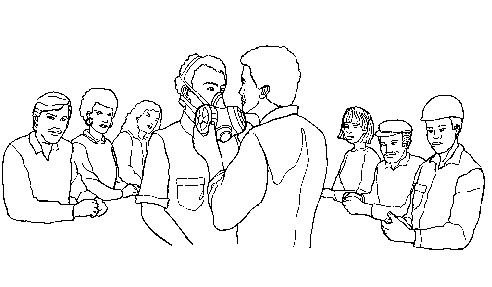 |
 |
|
|
|
Advantages and disadvantages of control methods |
||
METHOD |
ADVANTAGES |
DISADVANTAGES |
ELIMINATION |
||
1. Complete |
Health hazard is removed |
Possible sacrifice of production and loss of jobs |
2. Substitution |
Health hazard is removed and production continues |
New hazards may be introduced |
ISOLATION* |
||
1. Enclosure |
Maximum reduction of exposure |
Not 100 per cent under control; accidents and leaks possible |
2. Ventilation |
Some reduction of exposure |
Very problematic; largely inadequate on its own; exposures easily occur if not used with enclosure; only helps to control airborne hazards |
3. Sanitation and |
Minimal reduction of exposure |
Depends on work habits; offers little control on its own |
4. Personal protection |
Minimal reduction of exposure |
Depends on work habits; burden of control rests largely on the individual worker; contamination or failure of gear |
MONITOR |
Early warning of hazards |
None |
ORGANIZE; |
Prevention of hazards |
None |
*Isolation
methods are ranked from most effective (#1) to least effective (#4). |
||
Keeping a clean and organized workplace is an important method of controlling hazards. Good housekeeping (keeping a clean workplace) reduces the risk of fire and is cost-effective, since machines and tools that are cleaned regularly need less servicing. At the same time, maintaining a pleasant working environment can produce higher productivity. Good work practices include:
Good housekeeping, as a method of controlling hazards, should be planned when work processes are in the design stage, not after the factory is already operating. |
 |
 |
Planning ahead for good housekeeping can be as easy as installing shelves and window ledges that do not collect dust, or having the appropriate floors slightly sloping with gullies so that they can be easily washed. Use section V, General cleanliness in the Check-list on control methods at the back of this Module to help you assess the cleanliness and organization of your workplace.
Look around — does your workplace look clean and organized?
Are safety signs a method of control?
No! Employers often think they are demonstrating their commitment to safety by posting signs around the workplace such as: “Be safe, use machine guards”, “Safety is sense”, “Always use your protective equipment”. However, safety signs do not protect you and do not remove hazards. A safety sign can be, at best, a reminder or a warning about probable dangers. If they are used as safety reminders, signs should be changed regularly (otherwise you get used to them and do not notice them any more) and placed where you can easily see them.
Remember:
WARNING! |